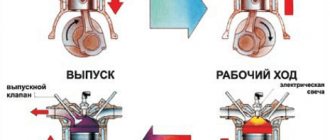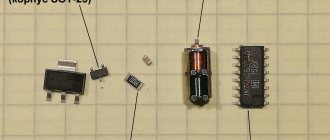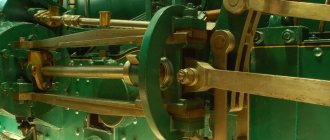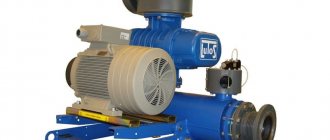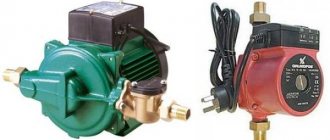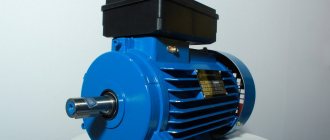When choosing power equipment, special attention must be paid to the type of engine. There are two types of internal combustion engines: 2-stroke and 4-stroke.
The principle of operation of an internal combustion engine is based on the use of such a property of gases as expansion when heated, which is carried out due to the forced ignition of a combustible mixture injected into the air space of the cylinder.
You can often hear that a 4-stroke engine is better, but to understand why, you need to take a closer look at how each works.
The main parts of an internal combustion engine, regardless of its type, are the crank and gas distribution mechanisms, as well as systems responsible for cooling, power supply, ignition and lubrication of parts.
The useful work of the expanding gas is transferred through a crank mechanism, and the gas distribution mechanism is responsible for the timely injection of the fuel mixture into the cylinder.
Four-stroke engines - Honda's choice
Four-stroke engines are economical, while their operation is accompanied by a lower noise level, and the exhaust does not contain a combustible mixture and is much more environmentally friendly than that of a two-stroke engine. That is why Honda uses only four-stroke engines in the manufacture of power equipment. Honda has been introducing its four-stroke engines to the power market for many years and has achieved the highest results, while their quality and reliability have never been questioned. But still, let's look at the principle of operation of 2 and 4 stroke engines.
Operating principle and main characteristics
The operating cycle of an internal combustion engine (ICE) consists of a series of processes that increase the power of the engine acting on the crankshaft. The work cycle consists of several stages:
- the cylinder is filled with the fuel mixture;
- the mixture is compressed;
- the fuel mixture ignites;
- the gases expand and the cylinder is cleaned.
In an internal combustion engine, the piston moves in one direction (up or down). The crankshaft makes one revolution in two strokes. The working stroke of the piston is the one during which useful work is performed and the burnt gases expand.
Two-stroke engines are those in which the cycle is completed in one revolution of the crankshaft or in two strokes. Four-stroke units are characterized by completing a working cycle in two revolutions of the crankshaft or in four strokes .
Main characteristic indicators of a 4-stroke engine:
- Due to the movement of the working piston, gases are exchanged.
- The unit is equipped with a gas distribution mechanism that allows the cylinder cavity to be switched to inlet and outlet.
- An exchange of gases occurs at the moment of a separate half-turn of the crankshaft.
- Gear reducers and a belt chain drive make it possible to change the timing of gasoline injection, ignition and gas distribution mechanism drive in relation to the crankshaft speed.
Assistance systems
Since a 4-stroke engine is more complex than a 2-stroke engine, for normal operation it needs auxiliary systems:
- Gas distribution - regulates the supply of the fuel mixture and the removal of exhaust gases using intake and exhaust valves.
- Lubrication - supplies oil to the engine, which reduces the friction force of mechanical parts, cools the mechanism and removes combustion products.
- Fuel supply is a system for supplying fuel from the gas tank to the cylinders. On older gasoline models, the creation of the fuel mixture occurs in the carburetor, and on injection engines, fuel is injected directly through the injectors.
- Ignition (on gasoline units) - the system alternately supplies current from the distributor to each spark plug, and from there to the combustion chambers. On some car models (for example, VAZ 2106), to increase the voltage supplied to the spark plugs, a capacitor is installed on the distributor.
- Cooling is an additional water circuit that removes excess heat from the engine.
- Exhaust system - cleans exhaust gases and releases them into the atmosphere.
Four-stroke internal combustion engine M57 from BMW.
The quality of operation and service life of the engine depend on the correct pressure inside the lubrication system , so it is recommended not only to rely on the oil pressure indicator in the cabin, but also to periodically carry out manual measurements using a pressure gauge.
Story
Around 1854-1857, the Italians Felicce Matoczi and Eugene Barsanti created a device that, according to the information available today, was similar to a four-stroke engine . The invention of the Italians was lost only in 1861. Alphon de Rocher patented an engine of this type.
The first workable four-stroke engine was created by the German engineer Nikolaus Otto . The four-stroke cycle of operation was named in his honor as the Otto cycle, and a 4-stroke engine using spark plugs is called an Otto engine.
How it all began
In the 19th century there were already engines, but they were mainly large mechanisms powered by steam. Of course, they partially provided for the developing industry, but had many disadvantages.
They were heavy, had low efficiency, large dimensions, required a lot of time to start and stop, and required skilled workers for operation.
Industrialists needed a new unit without the listed disadvantages; they already understood what a four-stroke engine means. And how, under certain conditions, it can be used to increase profits.
It was developed by the inventor Eugene-Alphonse Beau de Rochas, and in 1867 it was embodied in metal by Nikolaus August Otto.
At that time it was a miracle of technology. The internal combustion engine was characterized by low operating costs, small size and did not require the constant presence of maintenance personnel.
The device worked according to a special algorithm, which is still called the “Otto cycle”. 8 years later, after the launch of the first copy, Otto’s company was already producing more than 600 power units per year.
Very quickly, due to their autonomy and compactness, internal combustion engines became widespread.
Features of a 4-stroke engine
In a two-stroke engine, lubrication of the piston and cylinder pins, crankshaft, piston, bearing and compressor rings is carried out by pouring oil into gasoline. The crankshaft of a 4-stroke engine is located in an oil bath, which is a significant difference. That is why there is no need to mix fuel and add oil. All the car owner needs to do is fill the fuel tank with gasoline.
The car owner, therefore, has no need to purchase special oil, without which a two-stroke engine cannot function. In addition, with a four-stroke engine, the amount of carbon deposits on the piston mirror and on the walls of the muffler is reduced. Another important difference is that in a two-stroke engine, a flammable mixture splashes into the exhaust pipe, which is due to its design.
It should be recognized that four-stroke engines also have minor disadvantages. For example, their working moments for regulating the thermal valve clearance are not particularly high-quality.
Combustion and expansion (piston stroke) - four-stroke engine
Shortly before the end of the compression stroke, the combustible mixture is ignited by a spark from the spark plug. As the piston moves from TDC to BDC, the fuel burns, and under the influence of the heat of the burned fuel, the working mixture expands, pushing the piston. The degree of “under-rotation” of the engine crankshaft to TDC when the mixture is ignited is called the ignition timing angle. Ignition advance is necessary so that the gas pressure reaches its maximum value when the piston is at TDC. Then the use of energy from burned fuel will be maximum. The fuel combustion rate practically does not change, that is, it takes a fixed time, therefore, in order to achieve maximum engine performance, you need to increase the ignition timing in proportion to the crankshaft speed level. In older engines, this adjustment was made by a mechanical device (centrifugal and vacuum regulator acting on a breaker). More modern engines use electronic ignition timing to adjust the timing.
Unit design
The camshaft of a four-stroke engine is located in the cylinder cover. It is driven by a drive wheel mounted in the crankshaft. The camshaft opens and closes one of the valves: exhaust or intake, depending on the location of the piston. The camshaft also contains cams that operate the valve rocker arms.
Once triggered, the rocker arms It is important that there must be a thermal gap (narrow gap) between the adjusting screw and the valve. When heated, the metal expands, so if the gap is too small or there is none at all, the valves cannot completely close the exhaust and intake passages.
at the intake valve should be smaller than at the exhaust valve, because the exhaust gases are hotter than the mixture. Accordingly, the intake valve heats up less than the exhaust valves.
Compression stroke - two-stroke engine
The piston of a two-stroke engine rises from the BDC of the piston (in this position it is in Fig. 2) to the TDC of the piston (the position of the piston in Fig. 3), blocking first the purge 2 and then the exhaust 3 windows of the cylinder of a two-stroke engine. After the piston closes the outlet hole in the cylinder, compression of the previously entered fuel mixture begins. At the same time, in the crank chamber 1, due to its tightness and after the piston closes the purge windows 2, a vacuum is created under the piston, under the influence of which a combustible mixture enters the crank chamber of a two-stroke engine from the carburetor through the inlet window and the opening valve.
Engine operation
As already noted, the operation of a four-stroke engine consists of four strokes of the piston or two revolutions of the crankshaft.
Stages of work:
- Inlet . The piston moves downward, opening the intake valve. From the carburetor the combustible mixture enters the cylinder. When the piston reaches the bottom position, the intake valve closes.
- Compression . The piston moves upward, causing the combustible mixture to compress. When it approaches the top point, the compressed gasoline ignites.
- Extension . Gasoline ignites and burns. As a result, the flammable gases are stretched and the piston moves downwards. In this case, two valves are closed.
- Release . The crankshaft continues to move around its axis by inertia, and the piston moves upward. At the same time, the exhaust valve opens and exhaust gases enter the pipe. When the valve passes the dead center, the intake valve closes.
What determines the power of a four-stroke internal combustion engine?
Everything seems to be clear here - the power of a piston engine is mainly determined by:
- cylinder volume;
- compression ratio of the working mixture;
- rotation speed.
You can also increase the power of a four-stroke engine by increasing the throughput of the intake and exhaust strokes and increasing the diameter of the valves (especially the intake ones).
Also, maximum power is obtained when the cylinders are filled to the maximum; for this purpose, turbines for forced air pumping into the cylinder are used. As a result, the pressure in the cylinder increases and, accordingly, the engine efficiency increases significantly.
Power distribution in 2T and 4T engines
A 2T engine manages to use fuel combustion energy twice in two revolutions of the crankshaft. Many believe that it is twice as powerful as the 4T engine.
But pay attention, in the 2T engine part of the cylinder is occupied by the intake and exhaust ports, which means the amount of fuel that will then burn is less in volume than in the 4T engine, where the cylinder is solid.
In the 2T engine, due to the simplicity of its design, the crankshaft is lubricated by oil added to gasoline. Oil in the working mixture reduces the energy released (oil burns worse). Due to the peculiarities of the intake and exhaust of the combustible mixture and exhaust gases in the 2T engine, more of the combustible mixture “flies into the pipe” without burning.
In a 4T engine, this process is minimal due to a more complex intake-exhaust mechanism.
As a result, 2T engines are, indeed, at some point more powerful (but not twice as powerful), and their higher power is achieved in a narrower operating range of crankshaft revolutions (that is, at the start, a scooter with a 2T engine barely accelerates, then the so-called “catch-up” occurs, the scooter “shoots”, but quickly “fades”) and for dynamic driving you have to maintain a certain engine speed all the time.
Consequently, the more powerful the 2T engine, the narrower the speed range, the finer the settings and the more expensive the engine. Only athletes (where it is more important to squeeze everything out now), or owners of chainsaws and lawn mowers (for which the simpler and cheaper, the better) can fully enjoy the benefits of a 2T engine.
Even the slightly less powerful 4T engine has a more favorable characteristic than the 2T - it is “elastic”. Immediately from the start of movement, it will provide the scooter with good traction (it will pick up speed smoothly and confidently, without “dips” and “catch-ups”) and a confident increase in speed will be available throughout the entire crankshaft speed range.
The lack of power will only affect the upper operating speed range of the engine. And the 2T engine is exactly close to this operating mode and produces maximum power. But how long will equipment that is used to the limit last?
If you want to improve the dynamic characteristics of your scooter, you can install a kit to increase the engine displacement to 70 cc.m. After the modification, your scooter will not be inferior to the 2T model and the riding pleasure will be greater.
The first stroke is intake.
The structure of a modern engine
|
The piston moves from TDC to BDC, and purified air enters the cylinder through the open intake valve (due to the vacuum created by the piston). The air is mixed with a small amount of exhaust gases remaining from the previous cycle, the temperature rises and at the end of the intake stroke reaches 300-320 K, and the pressure 0.08-0.09 MPa. The cylinder filling coefficient is 0.9 or higher, i.e. more than that of a carburetor engine.
Diesel engines: history of creation and principle of operation
In 1892, the German engineer Rudolf Diesel (1859 - 1913) invented the engine that received his name.
In a diesel engine, the air-fuel mixture is compressed to a pressure approximately twice that of a gasoline engine. As a result, the mixture becomes so hot that it spontaneously ignites without an electric spark. Diesel engines are cheaper than gasoline engines. In addition, diesel engines have more power compared to gasoline engines.
Did you know that railway locomotives are equipped with a diesel engine; the wheelsets are driven by electric traction. The fact is that in diesel electric locomotives, the electrical energy that moves the wheels is generated by the operation of diesel engines. The turbopump constantly pumps air into the engine, increasing its power.
